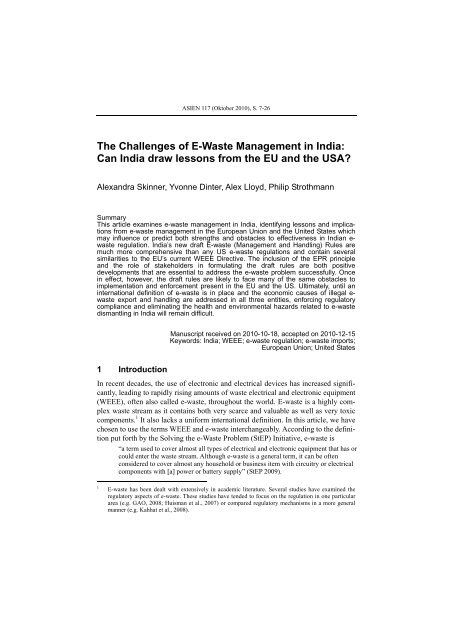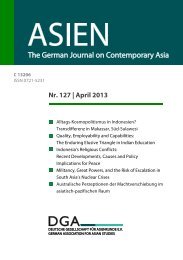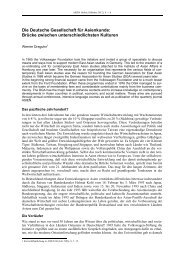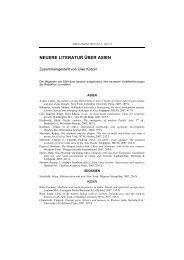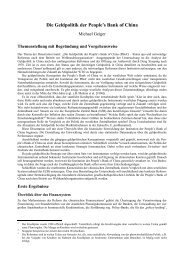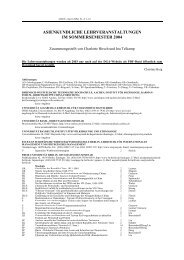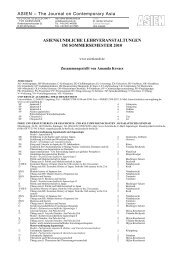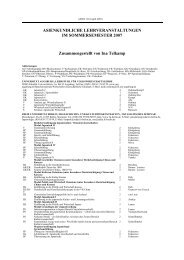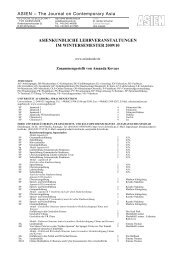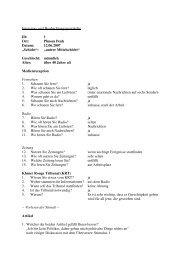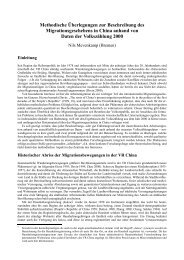The Challenges of E-Waste Management in India: Can India draw ...
The Challenges of E-Waste Management in India: Can India draw ...
The Challenges of E-Waste Management in India: Can India draw ...
Create successful ePaper yourself
Turn your PDF publications into a flip-book with our unique Google optimized e-Paper software.
ASIEN 117 (Oktober 2010), S. 7-26<br />
<strong>The</strong> <strong>Challenges</strong> <strong>of</strong> E-<strong>Waste</strong> <strong>Management</strong> <strong>in</strong> <strong>India</strong>:<br />
<strong>Can</strong> <strong>India</strong> <strong>draw</strong> lessons from the EU and the USA?<br />
Alexandra Sk<strong>in</strong>ner, Yvonne D<strong>in</strong>ter, Alex Lloyd, Philip Strothmann<br />
Summary<br />
This article exam<strong>in</strong>es e-waste management <strong>in</strong> <strong>India</strong>, identify<strong>in</strong>g lessons and implications<br />
from e-waste management <strong>in</strong> the European Union and the United States which<br />
may <strong>in</strong>fluence or predict both strengths and obstacles to effectiveness <strong>in</strong> <strong>India</strong>n ewaste<br />
regulation. <strong>India</strong>’s new draft E-waste (<strong>Management</strong> and Handl<strong>in</strong>g) Rules are<br />
much more comprehensive than any US e-waste regulations and conta<strong>in</strong> several<br />
similarities to the EU’s current WEEE Directive. <strong>The</strong> <strong>in</strong>clusion <strong>of</strong> the EPR pr<strong>in</strong>ciple<br />
and the role <strong>of</strong> stakeholders <strong>in</strong> formulat<strong>in</strong>g the draft rules are both positive<br />
developments that are essential to address the e-waste problem successfully. Once<br />
<strong>in</strong> effect, however, the draft rules are likely to face many <strong>of</strong> the same obstacles to<br />
implementation and enforcement present <strong>in</strong> the EU and the US. Ultimately, until an<br />
<strong>in</strong>ternational def<strong>in</strong>ition <strong>of</strong> e-waste is <strong>in</strong> place and the economic causes <strong>of</strong> illegal ewaste<br />
export and handl<strong>in</strong>g are addressed <strong>in</strong> all three entities, enforc<strong>in</strong>g regulatory<br />
compliance and elim<strong>in</strong>at<strong>in</strong>g the health and environmental hazards related to e-waste<br />
dismantl<strong>in</strong>g <strong>in</strong> <strong>India</strong> will rema<strong>in</strong> difficult.<br />
1 Introduction<br />
Manuscript received on 2010-10-18, accepted on 2010-12-15<br />
Keywords: <strong>India</strong>; WEEE; e-waste regulation; e-waste imports;<br />
European Union; United States<br />
In recent decades, the use <strong>of</strong> electronic and electrical devices has <strong>in</strong>creased significantly,<br />
lead<strong>in</strong>g to rapidly ris<strong>in</strong>g amounts <strong>of</strong> waste electrical and electronic equipment<br />
(WEEE), <strong>of</strong>ten also called e-waste, throughout the world. E-waste is a highly complex<br />
waste stream as it conta<strong>in</strong>s both very scarce and valuable as well as very toxic<br />
components. 1 It also lacks a uniform <strong>in</strong>ternational def<strong>in</strong>ition. In this article, we have<br />
chosen to use the terms WEEE and e-waste <strong>in</strong>terchangeably. Accord<strong>in</strong>g to the def<strong>in</strong>ition<br />
put forth by the Solv<strong>in</strong>g the e-<strong>Waste</strong> Problem (StEP) Initiative, e-waste is<br />
“a term used to cover almost all types <strong>of</strong> electrical and electronic equipment that has or<br />
could enter the waste stream. Although e-waste is a general term, it can be <strong>of</strong>ten<br />
considered to cover almost any household or bus<strong>in</strong>ess item with circuitry or electrical<br />
components with [a] power or battery supply” (StEP 2009).<br />
1 E-waste has been dealt with extensively <strong>in</strong> academic literature. Several studies have exam<strong>in</strong>ed the<br />
regulatory aspects <strong>of</strong> e-waste. <strong>The</strong>se studies have tended to focus on the regulation <strong>in</strong> one particular<br />
area (e.g. GAO, 2008; Huisman et al., 2007) or compared regulatory mechanisms <strong>in</strong> a more general<br />
manner (e.g. Kahhat et al., 2008).
8<br />
<strong>The</strong> <strong>Challenges</strong> <strong>of</strong> E-<strong>Waste</strong> <strong>Management</strong> <strong>in</strong> <strong>India</strong><br />
Over the last few decades, <strong>India</strong>, along with other Asian and African countries, has<br />
become a major dest<strong>in</strong>ation for e-waste exports from OECD countries. In addition,<br />
<strong>India</strong>ns have been generat<strong>in</strong>g rapidly <strong>in</strong>creas<strong>in</strong>g amounts <strong>of</strong> e-waste domestically. As<br />
<strong>of</strong> September 2010, there was no comprehensive regulation <strong>in</strong> effect cover<strong>in</strong>g the<br />
management, recycl<strong>in</strong>g and disposal <strong>of</strong> e-waste <strong>in</strong> <strong>India</strong> and the import <strong>of</strong> WEEE<br />
<strong>in</strong>to the country. Consequently, much <strong>of</strong> the domestic and imported WEEE ended up<br />
<strong>in</strong> illegal dismantl<strong>in</strong>g and recycl<strong>in</strong>g facilities where workers use processes hazardous<br />
to both their health and the environment. <strong>The</strong> new draft E-waste (<strong>Management</strong> and<br />
Handl<strong>in</strong>g) Rules, hereafter “draft rules” or simply “the draft”, are expected to come<br />
<strong>in</strong>to effect by the end <strong>of</strong> 2010. <strong>The</strong> draft rules aim to address both domestic e-waste<br />
management and the import <strong>of</strong> e-waste <strong>in</strong>to <strong>India</strong>.<br />
This paper focuses on how the problems surround<strong>in</strong>g e-waste regulation <strong>in</strong> other<br />
countries – particularly those that export to <strong>India</strong> – may <strong>in</strong>fluence or predict potential<br />
po<strong>in</strong>ts <strong>of</strong> success as well as obstacles to the effectiveness <strong>of</strong> <strong>India</strong>n regulation.<br />
We use the examples <strong>of</strong> WEEE management regulation and enforcement <strong>in</strong> two <strong>of</strong><br />
the world’s largest e-waste producers and the two biggest exporters <strong>of</strong> e-waste to<br />
<strong>India</strong>, the United States <strong>of</strong> America (US) and the European Union (EU). <strong>The</strong>se<br />
examples are useful for two reasons: firstly, obstacles encountered <strong>in</strong> implement<strong>in</strong>g<br />
and enforc<strong>in</strong>g e-waste regulation <strong>in</strong> the EU and the US may conta<strong>in</strong> important lessons<br />
for the implementation and enforcement <strong>of</strong> such regulation elsewhere – <strong>in</strong>clud<strong>in</strong>g<br />
the draft e-waste rules <strong>in</strong> <strong>India</strong>. Secondly, exam<strong>in</strong><strong>in</strong>g exist<strong>in</strong>g e-waste regulation<br />
and enforcement <strong>in</strong> these entities can reveal whether or not the EU and the US can<br />
be expected to stop or decrease exports to <strong>India</strong>. Both entities possess the technology<br />
to treat their own e-waste – so the questions <strong>of</strong> why and how some <strong>of</strong> this WEEE<br />
ends up <strong>in</strong> <strong>India</strong> and which laws the EU and the US have to regulate these exports<br />
are relevant to assess<strong>in</strong>g whether or not the <strong>India</strong>n regulation will be able to lessen<br />
the e-waste problem. If the EU and the US are unable to stop their own WEEE from<br />
be<strong>in</strong>g exported, <strong>India</strong> will cont<strong>in</strong>ue to carry a double burden <strong>in</strong> e-waste management,<br />
hav<strong>in</strong>g to address the handl<strong>in</strong>g <strong>of</strong> both the country’s own domestic e-waste and the<br />
imports.<br />
<strong>The</strong> paper first describes the sources <strong>of</strong> <strong>India</strong>n e-waste and the circumstances under<br />
which e-waste is currently recycled <strong>in</strong> <strong>India</strong>. It then presents an overview <strong>of</strong> the<br />
regulation and enforcement <strong>of</strong> e-waste management, particularly with regard to<br />
WEEE exports, <strong>in</strong> the US and the EU. Bear<strong>in</strong>g <strong>in</strong> m<strong>in</strong>d the strengths and weaknesses<br />
<strong>of</strong> regulation <strong>in</strong> the EU and the US, the paper then explores <strong>India</strong>n e-waste<br />
regulation and the provisions <strong>of</strong> the new draft rules. We conclude that the draft rules<br />
represent an impressive step <strong>in</strong> address<strong>in</strong>g the problems caused by e-waste <strong>in</strong> <strong>India</strong>,<br />
far surpass<strong>in</strong>g any attempts made by the US to regulate e-waste management and<br />
conta<strong>in</strong><strong>in</strong>g the same advanced EPR pr<strong>in</strong>ciples as the EU’s comprehensive WEEE<br />
regulation. Once <strong>in</strong> effect, however, the rules are likely to face many <strong>of</strong> the same<br />
obstacles to implementation and enforcement present <strong>in</strong> the EU and the US. We<br />
suggest that a unified <strong>in</strong>ternational def<strong>in</strong>ition for WEEE should be <strong>in</strong>troduced and
Alexandra Sk<strong>in</strong>ner, Yvonne D<strong>in</strong>ter, Alex Lloyd, Philip Strothmann 9<br />
additional policy approaches should be considered, <strong>in</strong>clud<strong>in</strong>g more research <strong>in</strong>to<br />
flexible mechanisms and regulations that not only provide specific methods <strong>of</strong><br />
enforcement, but also address the economic <strong>in</strong>centives to export and handle e-waste<br />
illegally. Until the economic causes <strong>of</strong> illegal e-waste export and handl<strong>in</strong>g are<br />
addressed worldwide, enforc<strong>in</strong>g regulatory compliance and elim<strong>in</strong>at<strong>in</strong>g the health<br />
and environmental hazards related to e-waste dismantl<strong>in</strong>g <strong>in</strong> <strong>India</strong> will rema<strong>in</strong><br />
difficult.<br />
This exploration <strong>of</strong> e-waste regulation <strong>in</strong> <strong>India</strong>, the US and the EU is only one aspect<br />
<strong>of</strong> a larger project conducted by the authors with the purpose <strong>of</strong> evaluat<strong>in</strong>g the<br />
effectiveness and susta<strong>in</strong>ability <strong>of</strong> the Basel Ban, an amendment to the Basel Convention<br />
on the Control <strong>of</strong> Transboundary Movements <strong>of</strong> Hazardous <strong>Waste</strong>s and their<br />
Disposal, proposed <strong>in</strong> 1995, which forbids the export <strong>of</strong> e-waste from OECD<br />
countries to non-OECD countries. This is a mechanism by which to address the<br />
problems caused by e-waste exports. Our conclusions <strong>in</strong> both the project and this<br />
article are based on expert <strong>in</strong>terviews and careful research <strong>of</strong> publications, statistics<br />
and studies on e-waste issued by government and bus<strong>in</strong>ess organisations, NGOs and<br />
academia. We <strong>in</strong>terviewed academic, NGO and European Commission experts<br />
<strong>in</strong>volved <strong>in</strong> the development and enforcement <strong>of</strong> WEEE legislation <strong>in</strong> both Europe<br />
and <strong>India</strong> as well as the Chief Operat<strong>in</strong>g Officer <strong>of</strong> ATTERO Recycl<strong>in</strong>g <strong>in</strong> <strong>India</strong>.<br />
2 Background: sources <strong>of</strong> e-waste and its management <strong>in</strong><br />
<strong>India</strong><br />
<strong>The</strong> complexity <strong>of</strong> e-waste flows with<strong>in</strong> <strong>India</strong> and <strong>in</strong>adequate record-keep<strong>in</strong>g by<br />
<strong>in</strong>dustry participants make an estimation <strong>of</strong> the quantities <strong>of</strong> e-waste with<strong>in</strong> <strong>India</strong><br />
difficult (Streiche-Porte et al., 2007: 36; S<strong>in</strong>ha, 2008: 36). However, a study limited<br />
to an exam<strong>in</strong>ation <strong>of</strong> computers, mobile phones and televisions reckoned that<br />
382,979 tonnes (t) <strong>of</strong> e-waste were generated <strong>in</strong> 2007, 50,000 t (approx. 13%) <strong>of</strong><br />
which were imported illegally (Khattar et al., 2007: 8). Of the e-waste imported <strong>in</strong>to<br />
<strong>India</strong>, it is estimated that approximately 80% is imported from the US, while the<br />
rema<strong>in</strong><strong>in</strong>g 20% is predom<strong>in</strong>antly imported from the EU (Sander & Schill<strong>in</strong>g, 2010:<br />
66; Pratap, 2009). Nonetheless, as the import <strong>of</strong> e-waste is illegal (Ja<strong>in</strong>, 2009: 2) and<br />
e-waste is <strong>of</strong>ten shipped via third countries (Pratap, 2009), it is unrealistic to expect<br />
these statistics to be exact.<br />
Of the estimated 382,979 t <strong>of</strong> e-waste generated <strong>in</strong> <strong>India</strong>, 144,143 t entered the ewaste<br />
stream. <strong>The</strong> e-waste not enter<strong>in</strong>g the waste stream became obsolete, but was<br />
not thrown away or sold (Khattar et al., 2007: 8). A pervasive view <strong>of</strong> e-waste as a<br />
commodity causes a reluctance to dispose <strong>of</strong> e-waste immediately (S<strong>in</strong>ha, 2008: 36),<br />
although modest <strong>in</strong>centives (e.g. a free c<strong>of</strong>fee mug) have been demonstrated to be<br />
effective <strong>in</strong> encourag<strong>in</strong>g disposal among consumers (Pratap, 2009).<br />
Because <strong>of</strong> the important role <strong>of</strong> the refurbishment and resale market <strong>in</strong> <strong>India</strong>, only<br />
19,000 t were ultimately recycled (Khattar et al., 2007: 8). As large household
10<br />
<strong>The</strong> <strong>Challenges</strong> <strong>of</strong> E-<strong>Waste</strong> <strong>Management</strong> <strong>in</strong> <strong>India</strong><br />
appliances constituted approximately 20% <strong>of</strong> the e-waste stream <strong>in</strong> <strong>India</strong> <strong>in</strong> 2007<br />
(Dwivedy & Mittal, 2009), the <strong>in</strong>clusion <strong>of</strong> these appliances <strong>in</strong>creases this figure by<br />
approximately 25%. <strong>The</strong> <strong>in</strong>formal sector recycles 90-95% <strong>of</strong> the e-waste recycled <strong>in</strong><br />
<strong>India</strong> (Khattar et al., 2007: 9; Raghupathy, 2009).<br />
<strong>The</strong> dom<strong>in</strong>ance <strong>of</strong> the <strong>in</strong>formal sector can be expla<strong>in</strong>ed by the toxic, yet efficient<br />
methods used <strong>in</strong> recycl<strong>in</strong>g. <strong>The</strong> toxicity <strong>of</strong> the <strong>in</strong>formal recycl<strong>in</strong>g sector has been<br />
widely covered <strong>in</strong> previous studies (Bridgen et al., 2005; Keller, 2006; Sepulveda et<br />
al., 2005; Sarkar, 2008). One study compar<strong>in</strong>g the activities <strong>of</strong> an <strong>in</strong>formal recycler<br />
us<strong>in</strong>g mercury amalgamation and cyanide leach<strong>in</strong>g to those <strong>of</strong> a formal recycler<br />
us<strong>in</strong>g an alternative gold-stripp<strong>in</strong>g substance found that while both recyclers<br />
achieved similar gold-recovery yields dur<strong>in</strong>g dismantl<strong>in</strong>g (16-56%), the <strong>in</strong>formal<br />
recycler’s yield dur<strong>in</strong>g chemical process<strong>in</strong>g was 36-60%, compared to 25-40%<br />
achieved by the formal recycler (Keller, 2006: 49). However, the formal recycler<br />
recovered additional gold when the waste liquids underwent further treatment. State<strong>of</strong>-the-art<br />
recyclers such as Umicore <strong>in</strong> Belgium and Attero <strong>in</strong> <strong>India</strong> can achieve<br />
gold-recovery rates <strong>of</strong> approximately 99%. This level <strong>of</strong> recovery <strong>in</strong>volves<br />
considerable extra cost, however, mak<strong>in</strong>g it difficult for state-<strong>of</strong>-the-art recyclers <strong>in</strong><br />
<strong>India</strong> to obta<strong>in</strong> enough e-waste to operate at full capacity (Gutpa, 2009).<br />
Although perhaps only slightly less efficient than recyclers not us<strong>in</strong>g state-<strong>of</strong>-the-art<br />
technology, the <strong>in</strong>formal recyclers’ process used between 3 and 21 kilograms <strong>of</strong><br />
chemicals, over 50 litres <strong>of</strong> water and lost between 1.3 and 3 grams <strong>of</strong> mercury to<br />
evaporation while recover<strong>in</strong>g a s<strong>in</strong>gle gram <strong>of</strong> gold and six grams <strong>of</strong> silver (Keller,<br />
2006). In the thirty litres <strong>of</strong> waste water produced and disposed <strong>of</strong> without further<br />
treatment, arsenic, lead, cadmium, copper, nickel and z<strong>in</strong>c were found at levels 5, 8,<br />
10, 370, 4.5 and 8.5 times the maximum threshold value established by Swiss<br />
legislation respectively (Keller, 2006). This level <strong>of</strong> toxicity is relatively high compared<br />
to the m<strong>in</strong>imal environmental hazards caused by the formal recycler, where<br />
the only potential hazard comes from stripped circuit boards stored <strong>in</strong> such a way<br />
that heavy metal can leach out. In the formal sector, recyclers pay to have their<br />
waste effluent sent to a treatment plant, thereby <strong>in</strong>creas<strong>in</strong>g their operat<strong>in</strong>g costs.<br />
With roughly similar recovery rates to formal recyclers be<strong>in</strong>g common across <strong>India</strong>,<br />
lower legislation compliance costs and the ability to externalise significant<br />
environmental costs (Streiche-Porte et al., 2007: 326), the <strong>in</strong>formal recycl<strong>in</strong>g sector<br />
is able to out-compete the formal sector, <strong>in</strong>clud<strong>in</strong>g state-<strong>of</strong>-the-art recyclers, <strong>in</strong><br />
bidd<strong>in</strong>g for e-waste <strong>in</strong> <strong>India</strong>. <strong>The</strong> <strong>in</strong>formal sector thus dom<strong>in</strong>ates e-waste recycl<strong>in</strong>g<br />
<strong>in</strong> <strong>India</strong> (Chaturvedi, 2009). Modell<strong>in</strong>g has also revealed that this dom<strong>in</strong>ance would<br />
be ma<strong>in</strong>ta<strong>in</strong>ed even if metal prices and concentrations were to move <strong>in</strong> favour <strong>of</strong><br />
formal recyclers (Streiche-Porte et al., 2007).
Alexandra Sk<strong>in</strong>ner, Yvonne D<strong>in</strong>ter, Alex Lloyd, Philip Strothmann 11<br />
Legislation designed to reduce the environmental hazards <strong>of</strong> e-waste recycl<strong>in</strong>g <strong>in</strong><br />
<strong>India</strong> thus needs to address the ability <strong>of</strong> <strong>in</strong>formal recyclers to outbid formal and<br />
state-<strong>of</strong>-the-art recyclers. Legislation must either prevent <strong>in</strong>formal recyclers from<br />
access<strong>in</strong>g e-waste <strong>in</strong> the same markets as formal recyclers or prevent them from<br />
externalis<strong>in</strong>g their costs. Ideally, this would be done <strong>in</strong> such a way that the <strong>in</strong>formal<br />
sector would be <strong>in</strong>tegrated <strong>in</strong>to the formal one.<br />
3 E-waste legislation and enforcement <strong>in</strong> the US and the EU<br />
<strong>The</strong> US and EU have developed different approaches for manag<strong>in</strong>g e-waste, diverg<strong>in</strong>g<br />
both <strong>in</strong> the legislative scope and the <strong>in</strong>struments’ effectiveness. By exam<strong>in</strong><strong>in</strong>g<br />
the effectiveness and enforcement <strong>of</strong> the two entities’ legislative approaches to manage<br />
e-waste, we hope to identify relevant features which may allow us to predict<br />
potential strengths and weaknesses <strong>of</strong> the new <strong>India</strong>n draft regulations. Although we<br />
believe the lessons <strong>draw</strong>n from the US and the EU are important for <strong>India</strong>n e-waste<br />
regulation, the US and EU’s experiences cannot illustrate exactly what to expect<br />
from the <strong>India</strong>n draft rules. <strong>India</strong>’s status as a country <strong>in</strong> transition and the recipient<br />
<strong>of</strong> e-waste exports <strong>in</strong>dicates that the e-waste problem <strong>in</strong> <strong>India</strong> is likely to encounter<br />
other obstacles <strong>in</strong> addition to those experienced <strong>in</strong> the US and the EU.<br />
E-waste regulations and enforcement <strong>in</strong> the EU<br />
<strong>The</strong> EU has been pass<strong>in</strong>g comprehensive and progressive e-waste legislation that is<br />
partly comparable to the new draft rules <strong>in</strong> <strong>India</strong> ever s<strong>in</strong>ce the mid-1990s. This<br />
legislation not only controls e-waste flows as stipulated <strong>in</strong> the <strong>Waste</strong> Shipment<br />
Regulation, but also governs the disposal and collection <strong>of</strong> WEEE (WEEE<br />
Directive) as well as the restriction <strong>of</strong> hazardous substances <strong>in</strong> electronic and<br />
electrical equipment (RoHS Directive).<br />
<strong>The</strong> export <strong>of</strong> e-waste is governed by Council Regulation No. 259/93, the so-called<br />
<strong>Waste</strong> Shipment Regulation (WSR), which was passed <strong>in</strong> 1993 and amended <strong>in</strong><br />
2007. Its ma<strong>in</strong> purpose is to control and regulate the supervision <strong>of</strong> waste shipments<br />
<strong>in</strong> order to prevent environmentally harmful shipments to countries without adequate<br />
provisions to deal with those wastes. Accord<strong>in</strong>g to the WSR, no EU member state is<br />
allowed to export e-waste classified as hazardous to non-OECD countries, <strong>in</strong>clud<strong>in</strong>g<br />
<strong>India</strong> (ECT/RWM, 2008: 14-15; IMPEL, 2004: 7-9). As a substantial number <strong>of</strong> ewaste<br />
components do not fall under the WSR’s def<strong>in</strong>ition <strong>of</strong> hazardous, however,<br />
these components may be exported to non-OECD countries under special provisions.<br />
<strong>The</strong>se provisions depend primarily on the import<strong>in</strong>g country’s acceptance <strong>of</strong><br />
such waste. <strong>The</strong> export <strong>of</strong> non-waste used electrical and electronic equipment (EEE)<br />
to non-OECD countries is allowed <strong>in</strong> pr<strong>in</strong>ciple (ECTS/RWM, 2008: 15; Huisman et<br />
al., 2007: 195).
12<br />
<strong>The</strong> <strong>Challenges</strong> <strong>of</strong> E-<strong>Waste</strong> <strong>Management</strong> <strong>in</strong> <strong>India</strong><br />
In addition to export regulations, the EU has passed e-waste legislation targeted at<br />
chang<strong>in</strong>g product designs and <strong>in</strong>creas<strong>in</strong>g recycl<strong>in</strong>g rates <strong>of</strong> discarded WEEE (Sander<br />
& Schill<strong>in</strong>g, 2010: 21). <strong>The</strong> WEEE (<strong>Waste</strong> Electrical and Electronic Equipment) and<br />
RoHS (Restriction <strong>of</strong> the use <strong>of</strong> certa<strong>in</strong> hazardous substances) Directives have been<br />
<strong>in</strong> force s<strong>in</strong>ce 2003. While the RoHS Directive addresses the beg<strong>in</strong>n<strong>in</strong>g <strong>of</strong> the EEE<br />
life cycle by attempt<strong>in</strong>g to elim<strong>in</strong>ate hazardous substances such as mercury, lead and<br />
fire retardants <strong>in</strong> domestically produced or imported electrical and electronic<br />
products, the WEEE Directive concentrates on the end-<strong>of</strong>-life stages <strong>of</strong> EEE. <strong>The</strong><br />
ma<strong>in</strong> objectives <strong>of</strong> the latter are to reduce the amount <strong>of</strong> EEE disposed <strong>of</strong> <strong>in</strong> landfills<br />
and to <strong>in</strong>crease recycl<strong>in</strong>g and recovery <strong>of</strong> e-waste. Member states are required to set<br />
up collection and treatment schemes where consumers can return their used e-waste<br />
free <strong>of</strong> charge.<br />
<strong>The</strong> Directive also <strong>in</strong>tends to encourage product designs that facilitate the recycl<strong>in</strong>g,<br />
repair, disassembly and reuse <strong>of</strong> WEEE by <strong>in</strong>troduc<strong>in</strong>g the concept <strong>of</strong> Extended<br />
Producer Responsibility (EPR). EPR allocates the f<strong>in</strong>ancial responsibility for<br />
collect<strong>in</strong>g and manag<strong>in</strong>g WEEE <strong>in</strong> l<strong>in</strong>e with the Directive to the producers (Hester &<br />
Harrison, 2009: 6). Individual Producer Responsibility (IPR) applies for the<br />
management <strong>of</strong> new products put on the market. For historical waste, i.e. products<br />
put on the market before 13 August 2005, the f<strong>in</strong>ancial responsibility is divided<br />
among producers <strong>in</strong> proportion to their market share <strong>of</strong> a specific type <strong>of</strong> equipment<br />
(WEEE Directive, Article 8). <strong>The</strong> rationale beh<strong>in</strong>d producer responsibility is the<br />
“polluter pays” pr<strong>in</strong>ciple, which <strong>in</strong>tends to <strong>in</strong>clude the costs <strong>of</strong> disposal and treatment<br />
<strong>in</strong> a product’s price, thus reflect<strong>in</strong>g the product’s environmental effects<br />
(Nnorom & Osibanjo, 2008: 845).<br />
Despite the wide-rang<strong>in</strong>g legislation, only a third <strong>of</strong> the WEEE aris<strong>in</strong>g <strong>in</strong> the EU is<br />
<strong>of</strong>ficially reported as be<strong>in</strong>g treated <strong>in</strong> l<strong>in</strong>e with the WEEE Directive. Part <strong>of</strong> the<br />
rema<strong>in</strong><strong>in</strong>g two thirds, which have been collected but not reported, is suspected <strong>of</strong><br />
be<strong>in</strong>g treated <strong>in</strong> the EU without appropriate environmental care or <strong>of</strong> be<strong>in</strong>g shipped<br />
illegally to treatment sites outside the EU that do not meet European environmental<br />
and health standards. Some <strong>of</strong> the e-waste may also be dumped <strong>in</strong> develop<strong>in</strong>g<br />
countries (EC, 2008a: 2).<br />
Although the current data situation regard<strong>in</strong>g e-waste shipments out <strong>of</strong> the EU is not<br />
sufficient to determ<strong>in</strong>e the exact quantities <strong>of</strong> e-waste be<strong>in</strong>g exported legally and<br />
illegally, some general tendencies can still be identified. 2 Only a small fraction <strong>of</strong> the<br />
total amount <strong>of</strong> WEEE generated <strong>in</strong> the EU is legally exported to non-EU countries,<br />
although the quantities <strong>of</strong> e-waste actually shipped are believed to be much higher<br />
2 <strong>The</strong> lack <strong>of</strong> sufficient and reliable data is due to a variety <strong>of</strong> reasons: data retrieved from trade<br />
statistics can only be used to a limited extent as these figures do not allow classification <strong>of</strong> EEE as<br />
waste, used or new products and only a small number <strong>of</strong> codes are clearly on WEEE (ETC/RWM,<br />
2008: 51); the potentially most reliable source at present, i.e. data report<strong>in</strong>g accord<strong>in</strong>g to the WEEE<br />
Directive, only started <strong>in</strong> 2005 and is published with a time lag. Fraud <strong>in</strong> documents also contributes<br />
to the difficulty <strong>of</strong> determ<strong>in</strong><strong>in</strong>g the true quantity <strong>of</strong> e-waste (EEA, 2009: 50).
Alexandra Sk<strong>in</strong>ner, Yvonne D<strong>in</strong>ter, Alex Lloyd, Philip Strothmann 13<br />
(ETC/RWM, 2008: 50-54). Both our <strong>in</strong>terview partners and studies conducted <strong>in</strong>dicate<br />
that a substantial amount <strong>of</strong> WEEE is still exported illegally despite EU legislation<br />
proscrib<strong>in</strong>g the export <strong>of</strong> e-waste to non-OECD countries (EC, 2008b: 5;<br />
Zoeteman et al., 2009: 29-30). <strong>The</strong> occurrence <strong>of</strong> illegal exports to non-OECD countries<br />
shows that both the WSR and the WEEE Directive have enforcement deficits. A<br />
brief overview <strong>of</strong> the ma<strong>in</strong> factors beh<strong>in</strong>d this situation is presented below.<br />
Although the complex regulatory system for waste shipment set up by the WSR has<br />
a significant impact on the export <strong>of</strong> WEEE, various legal and implementation issues<br />
hamper the legislation’s overall effectiveness. <strong>The</strong>se <strong>in</strong>clude a lack <strong>of</strong> capacity on<br />
the part <strong>of</strong> the authorities <strong>in</strong>volved, for <strong>in</strong>stance to pursue <strong>in</strong>spections more<br />
proactively; gaps <strong>in</strong> national law for enforcement <strong>in</strong> case <strong>of</strong> non-compliance; and<br />
legal grey areas <strong>in</strong> the WSR concern<strong>in</strong>g the classification problems regard<strong>in</strong>g waste,<br />
particularly the difficult dist<strong>in</strong>ction between function<strong>in</strong>g second-hand and waste<br />
products, among other th<strong>in</strong>gs (IMPEL, 2006: 22, 28). <strong>The</strong> lack <strong>of</strong> criteria for<br />
dist<strong>in</strong>guish<strong>in</strong>g new, used and waste products is one <strong>of</strong> the ma<strong>in</strong> reasons for illegal<br />
exports. Various cases have been detected <strong>in</strong> which used EEE was declared to be<br />
second-hand and function<strong>in</strong>g, when <strong>in</strong> fact it was not work<strong>in</strong>g and <strong>in</strong> part considered<br />
hazardous (ibid.: 49; Huisman et al., 2007: 195).<br />
<strong>The</strong> WEEE Directive <strong>in</strong>fluences both the management and – albeit rather <strong>in</strong>directly<br />
– the export <strong>of</strong> e-waste. <strong>The</strong> Directive does so by sett<strong>in</strong>g collection targets for<br />
recycl<strong>in</strong>g e-waste and try<strong>in</strong>g to promote reuse <strong>of</strong> WEEE while dim<strong>in</strong>ish<strong>in</strong>g its<br />
generation. However, there are <strong>in</strong>dications that the Directive’s exist<strong>in</strong>g requirements<br />
for treat<strong>in</strong>g the separately collected WEEE have not been effective (EC, 2008c: 2).<br />
<strong>The</strong> <strong>in</strong>terviews conducted even po<strong>in</strong>ted to an <strong>in</strong>crease <strong>in</strong> illegal e-waste exports as a<br />
result <strong>of</strong> the WEEE Directive – a situation quite contrary to its actual <strong>in</strong>tention. This<br />
situation results ma<strong>in</strong>ly from the fact that the high and ambitious environmental<br />
standards stipulated <strong>in</strong> the Directive <strong>in</strong>volve additional costs <strong>of</strong> treatment, likely<br />
fuell<strong>in</strong>g e-waste trade with non-OECD countries where the costs are much lower<br />
(EC, 2008b: 8).<br />
In an effort to address the Directive’s <strong>in</strong>sufficient effectiveness and efficiency, the<br />
European Commission proposed a revision <strong>of</strong> it <strong>in</strong> 2008. Several modifications<br />
currently under discussion could possibly help to reduce illegal e-waste exports to<br />
non-OECD countries. <strong>The</strong>se <strong>in</strong>clude sett<strong>in</strong>g a higher mandatory collection target for<br />
e-waste, establish<strong>in</strong>g m<strong>in</strong>imum monitor<strong>in</strong>g requirements for WEEE shipments and<br />
<strong>in</strong>troduc<strong>in</strong>g a legally b<strong>in</strong>d<strong>in</strong>g provision for the dist<strong>in</strong>ction between new, used or<br />
waste products to tackle the false labell<strong>in</strong>g <strong>of</strong> WEEE as used EEE (EC, 2008a: 7;<br />
Sander & Schill<strong>in</strong>g, 2010: 22).<br />
<strong>The</strong> European experience with legislat<strong>in</strong>g WEEE <strong>in</strong>dicates that <strong>India</strong>’s new draft<br />
rules may well experience similar enforcement problems. <strong>The</strong> European example<br />
has shown that enforcement issues related to e-waste legislation are not trivial and<br />
are ma<strong>in</strong>ly related to the nature <strong>of</strong> e-waste itself. Firstly, concern<strong>in</strong>g export regula-
14<br />
<strong>The</strong> <strong>Challenges</strong> <strong>of</strong> E-<strong>Waste</strong> <strong>Management</strong> <strong>in</strong> <strong>India</strong><br />
tions, the existence <strong>of</strong> many export po<strong>in</strong>ts, i.e. many different ports <strong>in</strong> the case <strong>of</strong><br />
transboundary shipments, and a huge number <strong>of</strong> goods exported with a relatively<br />
low specific value make it impossible to check all conta<strong>in</strong>ers or even control the<br />
reusability <strong>of</strong> second-hand EEE. Currently, spot checks exist and are go<strong>in</strong>g to be<br />
extended. Yet economic forces ultimately limit the effectiveness <strong>of</strong> these means even<br />
if they are comb<strong>in</strong>ed with jo<strong>in</strong>t enforcement and awareness-rais<strong>in</strong>g projects (e.g.<br />
IMPEL 2006). <strong>The</strong>se forces, driven by a huge demand for EEE <strong>in</strong> non-OECD<br />
countries and a significant price difference for the recycl<strong>in</strong>g/dismantl<strong>in</strong>g <strong>of</strong> e-waste<br />
between OECD and non-OECD countries (Basel Secretariat, 2009: 1-4), constitute<br />
the strongest <strong>in</strong>centive not to comply with export regulations at present. <strong>India</strong> is<br />
therefore likely to face similar problems related to the monitor<strong>in</strong>g <strong>of</strong> e-waste imports<br />
<strong>in</strong>to <strong>India</strong>.<br />
Secondly, <strong>in</strong> terms <strong>of</strong> legislation targeted at the disposal and collection <strong>of</strong> e-waste,<br />
the WEEE Directive’s recast po<strong>in</strong>ts to a number <strong>of</strong> problems <strong>India</strong> might also<br />
encounter when sett<strong>in</strong>g up a sophisticated collection system for e-waste. <strong>The</strong>se<br />
<strong>in</strong>clude issues such as the leakage <strong>of</strong> WEEE from the <strong>of</strong>ficial collection system (EC,<br />
2008a: 2), but also unnecessary adm<strong>in</strong>istrative costs for stakeholders <strong>in</strong> compliance<br />
with the Directive. <strong>The</strong>se costs stem, <strong>in</strong>ter alia, from differences <strong>in</strong> manag<strong>in</strong>g<br />
national producer registers which could apply on the state level <strong>in</strong> <strong>India</strong> (EC, 2008b:<br />
50).<br />
<strong>The</strong> example <strong>of</strong> the EU <strong>in</strong>dicates that clear legal provisions, <strong>in</strong>clud<strong>in</strong>g those for<br />
monitor<strong>in</strong>g and enforcement, the need to raise awareness <strong>of</strong> exist<strong>in</strong>g regulations<br />
among all relevant stakeholders and the recognition <strong>of</strong> e-waste’s potentially<br />
hazardous nature <strong>in</strong> conjunction with a more susta<strong>in</strong>able use and reuse <strong>of</strong> EEE are<br />
necessary for effective handl<strong>in</strong>g <strong>of</strong> e-waste.<br />
E-waste regulations and enforcement <strong>in</strong> the US<br />
Unlike the EU, the US Congress has failed to pass federal legislation specifically<br />
target<strong>in</strong>g either the national management or the export <strong>of</strong> WEEE. As a result, only<br />
two federal regulations address e-waste and its export: the Resource Conservation<br />
and Recovery Act <strong>of</strong> 1976 (RCRA) and the Environmental Protection Agency<br />
(EPA)’s CRT Rule.<br />
RCRA proscribes a “cradle to grave” track<strong>in</strong>g system for hazardous waste. <strong>The</strong> law<br />
requires <strong>in</strong>dividuals or companies handl<strong>in</strong>g, dispos<strong>in</strong>g <strong>of</strong> or shipp<strong>in</strong>g hazardous<br />
waste to obta<strong>in</strong> permits from the EPA and/or get permission from import<strong>in</strong>g countries<br />
(EPA 2009b; GAO, 2008: 32). However, RCRA conta<strong>in</strong>s two ma<strong>in</strong> loopholes<br />
that result <strong>in</strong> a failure to regulate most e-waste. Firstly, RCRA regulates WEEE disposal<br />
only when the electronics <strong>in</strong> question fall under the act’s def<strong>in</strong>ition <strong>of</strong> hazardous<br />
waste. When disposed <strong>of</strong> <strong>in</strong> landfills <strong>in</strong> the US, most e-waste does not meet this<br />
def<strong>in</strong>ition; when dismantled abroad, however, exposure to tox<strong>in</strong>s <strong>in</strong>creases (GAO,
Alexandra Sk<strong>in</strong>ner, Yvonne D<strong>in</strong>ter, Alex Lloyd, Philip Strothmann 15<br />
2008: 32; Puckett et al., 2002). Additionally, EPA has created exemptions for the<br />
export <strong>of</strong> certa<strong>in</strong> hazardous items (EPA, 2010b; ETBC, 2008: 6).<br />
Secondly, households and bus<strong>in</strong>esses produc<strong>in</strong>g up to 220 pounds <strong>of</strong> hazardous<br />
waste per month may dispose <strong>of</strong> that waste <strong>in</strong> landfills with<strong>in</strong> the US (EPA, 2010b).<br />
A good deal <strong>of</strong> the small amount <strong>of</strong> WEEE that falls under the hazardous-waste<br />
def<strong>in</strong>ition thus rema<strong>in</strong>s unregulated (GAO, 2009: 3-5). An unknown quantity <strong>of</strong> this<br />
waste may be shipped abroad. In sum, RCRA does little to regulate either the disposal<br />
<strong>of</strong> municipal e-waste with<strong>in</strong> the United States or its export.<br />
Only items conta<strong>in</strong><strong>in</strong>g cathode ray tubes, or CRTs, presently fall under RCRA’s<br />
def<strong>in</strong>ition <strong>of</strong> hazardous waste. Consequently, the EPA has created a rule regulat<strong>in</strong>g<br />
the disposal <strong>of</strong> these items, which are primarily televisions and computer monitors.<br />
If e-waste exporters wish to ship CRTs abroad for recycl<strong>in</strong>g, they are required to<br />
<strong>in</strong>form EPA <strong>of</strong> shipments planned for a period <strong>of</strong> 12 months or less; the EPA then<br />
contacts the import<strong>in</strong>g country and obta<strong>in</strong>s written permission for the shipments<br />
(EPA, 2009a).<br />
<strong>The</strong> CRT rule currently <strong>in</strong> effect also conta<strong>in</strong>s important loopholes that weaken its<br />
already limited regulation <strong>of</strong> US e-waste exports. Firstly, the rule only regulates the<br />
export <strong>of</strong> unsorted CRT glass and CRTs dest<strong>in</strong>ed for recycl<strong>in</strong>g. Exporters <strong>of</strong> <strong>in</strong>tact<br />
CRTs <strong>in</strong>tended for reuse merely need to submit a one-time notification <strong>of</strong> export to<br />
the EPA and ma<strong>in</strong>ta<strong>in</strong> records that prove that the CRTs will be reused. Notify<strong>in</strong>g the<br />
import<strong>in</strong>g country is not necessary (EPA, 2009a). Secondly, the EPA does not restrict<br />
the export <strong>of</strong> unused, <strong>in</strong>tact CRTs <strong>in</strong>tended for reuse or recycl<strong>in</strong>g or that <strong>of</strong> processed<br />
CRT glass (ibid.).<br />
Thus, as the federal government does not consider most e-waste hazardous, American<br />
recyclers may ship the electronics abroad with virtually no restriction. <strong>The</strong><br />
federal CRT rule limits exports, but only <strong>of</strong> a small fraction <strong>of</strong> the total e-waste<br />
stream. Furthermore, a GAO (2008) study turned up significant evidence that the<br />
EPA has failed to implement and enforce the CRT rule. Many recyclers either<br />
directly violate the rule by not notify<strong>in</strong>g the EPA <strong>of</strong> their exports or seek to<br />
circumvent it by labell<strong>in</strong>g shipments as dest<strong>in</strong>ed for reuse, regardless <strong>of</strong> the<br />
electronics’ actual level <strong>of</strong> functionality. <strong>The</strong>y have received few sanctions (ibid;<br />
GAO, 2005a: 14-15). 3<br />
In the absence <strong>of</strong> federal legislation regulat<strong>in</strong>g most types <strong>of</strong> e-waste disposal, an<br />
<strong>in</strong>creas<strong>in</strong>g number <strong>of</strong> US states have begun to develop their own e-waste regulation<br />
and management systems. 23 states have passed EPR legislation that restricts the<br />
disposal <strong>of</strong> certa<strong>in</strong> types <strong>of</strong> e-waste, but the strength and scope <strong>of</strong> the provisions<br />
3 In August 2010, the EPA announced “clean<strong>in</strong>g up e-waste” as one <strong>of</strong> its six new <strong>in</strong>ternational<br />
priorities (EPA, 2010c). <strong>The</strong> announcement <strong>in</strong>dicates that changes <strong>in</strong> this area might occur <strong>in</strong> the near<br />
future.
16<br />
<strong>The</strong> <strong>Challenges</strong> <strong>of</strong> E-<strong>Waste</strong> <strong>Management</strong> <strong>in</strong> <strong>India</strong><br />
vary greatly from state to state. <strong>The</strong> other 27 states have no restrictions on e-waste<br />
disposal.<br />
Although state programmes have had some success <strong>in</strong> <strong>in</strong>creas<strong>in</strong>g recycl<strong>in</strong>g, the<br />
states are also encounter<strong>in</strong>g enforcement problems due to their limited powers and<br />
the vast scope <strong>of</strong> WEEE. Additionally, their power to enforce their legislation ends<br />
at their borders (NREC, 2006: 15). As a result, the five states whose laws seek to<br />
restrict or impose conditions on the <strong>in</strong>ternational export <strong>of</strong> e-waste can do very little<br />
to enforce these provisions.<br />
Indeed, the “patchwork” <strong>of</strong> state laws has <strong>in</strong>directly resulted <strong>in</strong> an <strong>in</strong>crease <strong>in</strong> ewaste<br />
exports for two reasons. Firstly, exports are grow<strong>in</strong>g because the state laws<br />
mandat<strong>in</strong>g recycl<strong>in</strong>g are work<strong>in</strong>g. <strong>The</strong> percentage <strong>of</strong> e-waste collected for recycl<strong>in</strong>g<br />
has <strong>in</strong>deed <strong>in</strong>creased <strong>in</strong> recent years (EPA 2008: 23; Wagner 2009; GAO 2005b: 15).<br />
S<strong>in</strong>ce recyclers export the large majority <strong>of</strong> that WEEE, <strong>in</strong>creas<strong>in</strong>g amounts <strong>of</strong> waste<br />
and a higher percentage <strong>of</strong> recycled products almost certa<strong>in</strong>ly <strong>in</strong>dicate higher absolute<br />
and per capita export volumes (GAO 2008: 42; Tonetti 2007: 6).<br />
Secondly, the absence <strong>of</strong> federal e-waste laws strengthens the exist<strong>in</strong>g economic<br />
<strong>in</strong>centive to export e-waste. American recyclers and manufacturers send their ewaste<br />
abroad because recyclers <strong>in</strong> develop<strong>in</strong>g and transition countries can extract the<br />
precious materials more cheaply (Puckett et al., 2002). In the absence <strong>of</strong> a national<br />
collection system, electronics recyclers operat<strong>in</strong>g <strong>in</strong> the United States have difficulty<br />
obta<strong>in</strong><strong>in</strong>g enough e-waste to operate their expensive mach<strong>in</strong>ery at an economy <strong>of</strong><br />
scale. As <strong>in</strong> the EU, the environmentally sound treatment <strong>of</strong> e-waste <strong>in</strong>curs high<br />
costs, thereby encourag<strong>in</strong>g illegal trade. Furthermore, with few regulations<br />
attempt<strong>in</strong>g to <strong>in</strong>fluence or encourage changes <strong>in</strong> product designs, electronic products<br />
become obsolete quickly and rema<strong>in</strong> difficult and expensive to disassemble <strong>in</strong> both<br />
the US and the EU (GAO, 2005a: 9)<br />
As a result, the state e-waste laws actually make WEEE management and recycl<strong>in</strong>g<br />
<strong>in</strong> the US more economically <strong>in</strong>efficient. Each state’s regulations differ from the<br />
others’ and sometimes even conflict with them. This regulatory “patchwork” has<br />
significantly <strong>in</strong>creased the costs to both e-waste recyclers and electronics<br />
manufacturers (NCER, 2006; Daly, 2006; GAO, 2005b: 17-18). One study found<br />
that comply<strong>in</strong>g with and enforc<strong>in</strong>g the 20 overlapp<strong>in</strong>g and conflict<strong>in</strong>g state<br />
regulations costs government, recyclers and electronics manufacturers an extra<br />
US$125 million per year (NCER, 2006). Several voluntary programmes run by<br />
manufacturers exist, but these have not been very successful at <strong>in</strong>creas<strong>in</strong>g the<br />
recycl<strong>in</strong>g volume, especially <strong>in</strong> states without any e-waste regulation (Wagner, 2009:<br />
3017; Daly, 2006; Dempsey, 2009). <strong>The</strong> large amount <strong>of</strong> e-waste currently<br />
stockpiled <strong>in</strong> US bus<strong>in</strong>esses and households and be<strong>in</strong>g disposed <strong>of</strong> <strong>in</strong> landfills<br />
represents a tremendous economic opportunity for the US recycl<strong>in</strong>g <strong>in</strong>dustry.<br />
However, most electronics manufacturers and recyclers agree that this potential<br />
cannot be realised without a federal e-waste programme (NCER, 2006; Daly, 2006).
Alexandra Sk<strong>in</strong>ner, Yvonne D<strong>in</strong>ter, Alex Lloyd, Philip Strothmann 17<br />
<strong>The</strong> situation <strong>in</strong> the United States has a number <strong>of</strong> implications for the effectiveness<br />
<strong>of</strong> e-waste management regulation <strong>in</strong> <strong>India</strong>. On the positive side, <strong>India</strong>, while also a<br />
federal system, appears to have escaped the US problem <strong>of</strong> conflict<strong>in</strong>g state regulations<br />
by creat<strong>in</strong>g the draft rules on a national level. <strong>The</strong>re are also several more<br />
problematic implications for <strong>India</strong> found <strong>in</strong> the American example, however.<br />
Firstly, the US does not appear to enforce the part <strong>of</strong> its WEEE legislation that<br />
regulates exports. Given the limited scope <strong>of</strong> federal regulation concern<strong>in</strong>g these<br />
exports, this failure seems to be less a question <strong>of</strong> capacity than <strong>of</strong> will<strong>in</strong>gness<br />
(ETBC, 2008). However, the US does face a number <strong>of</strong> real obstacles to regulat<strong>in</strong>g<br />
e-waste. For <strong>in</strong>stance, the lack <strong>of</strong> a common e-waste def<strong>in</strong>ition both at home and<br />
<strong>in</strong>ternationally makes the creation <strong>of</strong> legislation difficult. Without an <strong>in</strong>ternational<br />
customs code differentiat<strong>in</strong>g between different types <strong>of</strong> e-waste, the EPA would have<br />
difficulty identify<strong>in</strong>g and monitor<strong>in</strong>g shipments sent abroad (GAO, 2008). In the<br />
case <strong>of</strong> <strong>India</strong>, this could <strong>in</strong>dicate a potential difficulty <strong>in</strong> monitor<strong>in</strong>g <strong>in</strong>com<strong>in</strong>g<br />
shipments. As also seen <strong>in</strong> the EU, the large number <strong>of</strong> ports deal<strong>in</strong>g with e-waste<br />
shipments also makes reliable enforcement difficult. <strong>India</strong> will face many <strong>of</strong> these<br />
same logistical problems when try<strong>in</strong>g to control e-waste collection and imports. In<br />
addition, the lack <strong>of</strong> enforcement <strong>in</strong> the US puts virtually the entire burden <strong>of</strong><br />
stopp<strong>in</strong>g US e-waste exports on <strong>India</strong>’s shoulders.<br />
Moreover, the experience on the US state level <strong>in</strong>dicates that enforc<strong>in</strong>g compliance<br />
with e-waste regulations can <strong>in</strong>volve a great deal <strong>of</strong> expense. Track<strong>in</strong>g down manufacturers<br />
and/or consumers <strong>of</strong> electronics to hold them responsible for their waste<br />
can be costly, time-consum<strong>in</strong>g and burdensome for both state and federal governments<br />
(Wagner, 2009; NCER, 2006; Daly, 2006). This cost dis<strong>in</strong>centive, the economic<br />
<strong>in</strong>centive for recyclers and collectors to dispose <strong>of</strong> e-waste illegally and the<br />
complex logistics <strong>in</strong>volved <strong>in</strong> monitor<strong>in</strong>g e-waste have all proven to be major obstacles<br />
to enforcement <strong>in</strong> both the US and the EU. Additionally, differences <strong>in</strong> implementation<br />
and enforcement between the <strong>India</strong>n states could lead to a version <strong>of</strong> the<br />
patchwork situation that exists <strong>in</strong> the US, complete with additional costs for companies<br />
and governments. <strong>The</strong> American example thus <strong>in</strong>dicates several potential<br />
obstacles that <strong>India</strong> may encounter while try<strong>in</strong>g to implement and enforce<br />
regulations concern<strong>in</strong>g not only e-waste imports but domestically generated WEEE<br />
as well.<br />
4 E-waste regulation <strong>in</strong> <strong>India</strong><br />
<strong>The</strong> environmentally sound management <strong>of</strong> e-waste is a significant challenge for<br />
<strong>India</strong>. <strong>The</strong> challenge relates not only to imported e-waste, but also to the <strong>in</strong>creas<strong>in</strong>g<br />
amounts <strong>of</strong> domestically produced WEEE. Despite this situation, as <strong>of</strong> September<br />
2010, neither the central government nor the state governments had legislation <strong>in</strong><br />
effect solely dedicated to e-waste. <strong>The</strong> follow<strong>in</strong>g section exam<strong>in</strong>es the current<br />
regulatory framework for e-waste <strong>in</strong> <strong>India</strong>, exam<strong>in</strong><strong>in</strong>g exist<strong>in</strong>g legislation, voluntary
18<br />
<strong>The</strong> <strong>Challenges</strong> <strong>of</strong> E-<strong>Waste</strong> <strong>Management</strong> <strong>in</strong> <strong>India</strong><br />
e-waste guidel<strong>in</strong>es released by the central government, and the new draft rules dedicated<br />
to e-waste management.<br />
<strong>The</strong> Environment (Protection) Act (EPA), enacted <strong>in</strong> 1986 follow<strong>in</strong>g the Bhopal gas<br />
tragedy, was the first comprehensive environmental law. <strong>The</strong> Act only def<strong>in</strong>ed<br />
hazardous waste <strong>in</strong> very broad terms and did not address e-waste at all (Abraham &<br />
Abraham, 1991). However, what it did do was confer the power to enact regulations<br />
concern<strong>in</strong>g environmental issues on the executive. S<strong>in</strong>ce then, the precautionary and<br />
the “polluter pays” pr<strong>in</strong>ciple have both become part <strong>of</strong> <strong>India</strong>n environmental policy.<br />
Yet despite these developments, no regulation on e-waste has been enacted and no<br />
<strong>India</strong>n environmental law has implemented or enforced the concept <strong>of</strong> EPR to its<br />
full extent (Mohan et al., 2008: 183).<br />
Although no e-waste laws currently exist, two regulations established under the<br />
provisions <strong>of</strong> the EPA – the Hazardous <strong>Waste</strong> (<strong>Management</strong> and Handl<strong>in</strong>g) (HWM)<br />
Rules and the Batteries (<strong>Management</strong> and Handl<strong>in</strong>g) Rules – are applicable to some<br />
extent (Alexeew et al., 2009: 6). <strong>The</strong> <strong>India</strong>n Municipal Solid <strong>Waste</strong>s (<strong>Management</strong><br />
and Handl<strong>in</strong>g) Rules <strong>of</strong> 2000 do not cover e-waste at all (Mohan et al., 2008: 184),<br />
although some e-waste could potentially be regulated on a municipal level.<br />
<strong>The</strong> HWM Rules require any company or <strong>in</strong>dividual receiv<strong>in</strong>g, treat<strong>in</strong>g, transport<strong>in</strong>g<br />
or stor<strong>in</strong>g hazardous waste to first obta<strong>in</strong> permission from the relevant State<br />
Pollution Control Board (SPCB). Furthermore, the HWM Rules also banned the<br />
import <strong>of</strong> hazardous waste for disposal or dump<strong>in</strong>g. <strong>The</strong> central government can,<br />
however, issue an import authorisation for hazardous waste that is to be processed or<br />
reused. An amendment to the HWM Rules <strong>in</strong> 2000 expanded the scope <strong>of</strong> the Rules<br />
to <strong>in</strong>clude provisions on e-waste for the first time. However, these provisions only<br />
applied to import and export activities (HWM Amendment Rules, 2000).<br />
<strong>The</strong> new Hazardous <strong>Waste</strong>s <strong>Management</strong>, Handl<strong>in</strong>g and Transboundary Movement<br />
Rules <strong>of</strong> 2008 replaced the old HWM rules and now conta<strong>in</strong> additional provisions<br />
on e-waste handl<strong>in</strong>g with<strong>in</strong> <strong>India</strong>. <strong>The</strong>se provisions require every person plann<strong>in</strong>g to<br />
recycle or reprocess e-waste to obta<strong>in</strong> prior authorisation from the relevant SPCB.<br />
However, the SPCB registration process has been criticised for grant<strong>in</strong>g the same<br />
authorisation to collectors, dismantlers and recyclers without assess<strong>in</strong>g their<br />
capability to treat the e-waste <strong>in</strong> an environmentally sound manner (Gupta, 2009).<br />
Furthermore, responsibility is split between the states and the federal government.<br />
<strong>The</strong> central government authorises <strong>in</strong>dividuals import<strong>in</strong>g e-waste for process<strong>in</strong>g or<br />
reuse, and the SPCBs authorise collectors, dismantlers and recyclers.<br />
<strong>The</strong> Batteries (<strong>Management</strong> and Handl<strong>in</strong>g) Rules exclusively cover lead acid batteries<br />
and thus have a very limited impact on e-waste. <strong>The</strong> Batteries (<strong>Management</strong> and<br />
Handl<strong>in</strong>g) Rules were, however, the first regulation to implement aspects <strong>of</strong> EPR <strong>in</strong><br />
<strong>India</strong>. Under the regulation, manufacturers, importers and assemblers are responsible<br />
for organis<strong>in</strong>g a collective take-back system for batteries. <strong>The</strong>y must also ensure that<br />
the batteries are then handed to registered recyclers (Batteries (Manag<strong>in</strong>g and
Alexandra Sk<strong>in</strong>ner, Yvonne D<strong>in</strong>ter, Alex Lloyd, Philip Strothmann 19<br />
Handl<strong>in</strong>g) Rules, 2001). Dr. Raghupathy (2009), advisor to the Manufacturer’s<br />
Association for Information Technology (MAIT) and author <strong>of</strong> the new draft rules<br />
on e-waste, has criticised the Batteries rules’ lack <strong>of</strong> an effective enforcement<br />
mechanism and argued that the rules have failed because the collection system<br />
failed.<br />
As <strong>in</strong> the US, the patchwork <strong>of</strong> regulations cover<strong>in</strong>g e-waste has led to a number <strong>of</strong><br />
problems that hamper WEEE regulation and enforcement (S<strong>in</strong>ha-Ketriwal et al.,<br />
2005: 498). Like the lack <strong>of</strong> differentiation between new, used and old EEE <strong>in</strong> EU<br />
customs codes, customs documents under the current <strong>India</strong>n regulatory system do<br />
not differentiate between old and new computers. Only one export-import (EXIM)<br />
code exists for both old and new computers, prevent<strong>in</strong>g targeted compliance<br />
monitor<strong>in</strong>g (S<strong>in</strong>ha, 2008: 33). Furthermore, imports are <strong>of</strong>ten falsely declared to be<br />
for charity, go<strong>in</strong>g <strong>in</strong>stead to <strong>in</strong>formal recyclers or becom<strong>in</strong>g e-waste with<strong>in</strong> two or<br />
three years (Basu, 2008: 45).<br />
<strong>The</strong> allocation <strong>of</strong> responsibility under exist<strong>in</strong>g legislation also causes problems.<br />
Responsibility for monitor<strong>in</strong>g some activities falls to the states, while the federal<br />
government is responsible for others. As <strong>in</strong> the US, this can be expected to <strong>in</strong>crease<br />
compliance costs for formal recyclers and cause difficulties <strong>in</strong> enforcement and<br />
monitor<strong>in</strong>g <strong>in</strong> an environment where capacity is both limited and stra<strong>in</strong>ed. In a<br />
similar ve<strong>in</strong> to the CRT legislation <strong>in</strong> the US, the EPR system <strong>in</strong>troduced by the<br />
Battery Rules operates <strong>in</strong> isolation. Lack<strong>in</strong>g an effective enforcement mechanism,<br />
the legislation rema<strong>in</strong>s <strong>in</strong>effective. This comb<strong>in</strong>ation <strong>of</strong> factors has resulted <strong>in</strong> the<br />
dom<strong>in</strong>ance <strong>of</strong> the <strong>in</strong>formal recycl<strong>in</strong>g sector as environmentally sound recyclers have<br />
difficulty sourc<strong>in</strong>g enough e-waste to operate at capacity (Gutpa, 2009; Schreiber,<br />
2009). Many stakeholders have thus argued that “the absence <strong>of</strong> legislation is one <strong>of</strong><br />
the biggest stumbl<strong>in</strong>g blocks <strong>in</strong> implement<strong>in</strong>g an e-waste management system”<br />
(GTZ et al., 2009: 4). Stakeholder contributions to the draft rules on e-waste<br />
published by the M<strong>in</strong>istry <strong>of</strong> Environment and Forestry (MoEF) <strong>in</strong> 2009 are thus all<br />
the more important (Saroj, 2009).<br />
<strong>The</strong> draft E-waste (<strong>Management</strong> and Handl<strong>in</strong>g) Rules are the most recent attempt to<br />
regulate e-waste <strong>in</strong> <strong>India</strong>. <strong>The</strong>y are not the first one, however. Largely as a result <strong>of</strong><br />
pressure from stakeholders follow<strong>in</strong>g the publication <strong>of</strong> the Toxics L<strong>in</strong>k study on ewaste<br />
<strong>in</strong> 2002, the Central Pollution Control Board (CPCB) released guidel<strong>in</strong>es on<br />
e-waste management <strong>in</strong> 2008. <strong>The</strong>se guidel<strong>in</strong>es advocated the voluntary adoption <strong>of</strong><br />
producer responsibility, the restriction <strong>of</strong> hazardous substances (RoHS) <strong>in</strong><br />
manufactur<strong>in</strong>g and the adoption <strong>of</strong> environmentally susta<strong>in</strong>able technologies <strong>in</strong> ewaste<br />
recycl<strong>in</strong>g (Chaturvedi, 2008: 15; Raghupathy, 2009). However, Dr. Saroj,<br />
from the <strong>India</strong>n M<strong>in</strong>istry <strong>of</strong> Environment and Forests (MoEF), has acknowledged<br />
that the guidel<strong>in</strong>es are obsolete because nobody actually adheres to them (Saroj,<br />
2009). <strong>The</strong> failure <strong>of</strong> previous attempts at e-waste regulation makes the current draft<br />
rules’ success all the more urgent.
20<br />
<strong>The</strong> <strong>Challenges</strong> <strong>of</strong> E-<strong>Waste</strong> <strong>Management</strong> <strong>in</strong> <strong>India</strong><br />
<strong>The</strong> latest version <strong>of</strong> the draft rules was made available by the MoEF on 14 May<br />
2010 and was opened for comments until the end <strong>of</strong> July. While the draft rules have<br />
not entered <strong>in</strong>to force yet, we do not expect any significant changes to be made to<br />
them. <strong>The</strong> draft’s scope <strong>in</strong>cludes all the stakeholders <strong>in</strong>volved <strong>in</strong> e-waste handl<strong>in</strong>g,<br />
with a focus on producers, dealers, refurbishers, collection centres, consumers,<br />
dismantlers and recyclers. <strong>The</strong> regulation is based entirely on the EPR and IPR<br />
pr<strong>in</strong>ciples. If enacted, it would be the first piece <strong>of</strong> <strong>India</strong>n regulation to <strong>in</strong>tegrate<br />
these pr<strong>in</strong>ciples comprehensively.<br />
<strong>The</strong> draft rules state that e-waste producers have to ensure that their waste products<br />
cause no harm and that their products have been produced <strong>in</strong> l<strong>in</strong>e with the Reduction<br />
<strong>in</strong> the use <strong>of</strong> Hazardous Substances (RoHS) <strong>in</strong> the manufacture <strong>of</strong> electrical and<br />
electronic equipment requirements. <strong>The</strong>y will also have to ensure that all their products<br />
have a unique serial number or <strong>in</strong>dividual identification code and take<br />
responsibility for all previously generated waste branded with their name. Additionally,<br />
producers are responsible for implement<strong>in</strong>g and f<strong>in</strong>anc<strong>in</strong>g an effective takeback<br />
system only <strong>in</strong>volv<strong>in</strong>g authorised stakeholders (MoEF, 2010: 4).<br />
E-waste dealers, refurbishers, dismantlers, recyclers and collection centres are all<br />
required to register with the relevant State Pollution Control Board (SPCB) or Pollution<br />
Control Committee (PCC). <strong>The</strong>y are also required to comply with detailed<br />
provisions on how to handle the e-waste to ensure that they do not create any health<br />
hazards or harm the environment. Dealers <strong>of</strong> electrical equipment are responsible for<br />
collect<strong>in</strong>g e-waste by provid<strong>in</strong>g a collection box. <strong>The</strong>y are also required to submit<br />
<strong>in</strong>formation about the e-waste collected to the SPCB or PCC (MoEF, 2010: 5-9).<br />
Although the draft rules require consumers to dispose <strong>of</strong> e-waste by tak<strong>in</strong>g it to<br />
authorised dealers and collection centres, large consumers are still allowed to<br />
auction their waste. However, they may only auction it to authorised collection<br />
centres, dismantlers, recyclers or to the collection services <strong>of</strong>fered by the producers<br />
(MoEF, 2010: 7).<br />
<strong>The</strong> draft rules assign all responsibility for ensur<strong>in</strong>g enforcement to the respective<br />
SPCB or PCC. Every <strong>in</strong>stitution registered by the authorities has to provide the<br />
SPCB or PCC with annual reports. If a registered and authorised <strong>in</strong>stitution fails to<br />
comply with the regulations, the SPCB or PCC may revoke its authorisation (MoEF,<br />
2010: 9). However, the draft does not specify any further concrete measures to<br />
ensure proper monitor<strong>in</strong>g, implementation and enforcement. This could lead to<br />
future implementation and enforcement problems, particularly given the previous<br />
reluctance <strong>of</strong> producers to take responsibility for their waste, the failure to enforce<br />
EPR <strong>in</strong> the Batteries Rules, and the complex logistics and high potential costs<br />
<strong>in</strong>volved <strong>in</strong> track<strong>in</strong>g and collect<strong>in</strong>g e-waste seen <strong>in</strong> other countries.<br />
Importantly, the draft rules also address imports. An <strong>in</strong>itial draft <strong>of</strong> the rules stipulated<br />
that imports would not be allowed for recycl<strong>in</strong>g or disposal. WEEE imported<br />
for refurbishment or repair would be allowed “subject to the same be<strong>in</strong>g exported”
Alexandra Sk<strong>in</strong>ner, Yvonne D<strong>in</strong>ter, Alex Lloyd, Philip Strothmann 21<br />
(MAIT, 2009: 12). However, the latest draft simply states that: “Every [sic!] producer(s),<br />
dealer(s), collection centre(s), refurbisher(s), dismantler(s), recycler(s),<br />
auctioneer(s) consumer(s) or bulk consumer(s) shall not import used electrical and<br />
electronic equipment <strong>in</strong> <strong>India</strong> for use” (MoEF, 2010: 12). This total import ban will<br />
be very difficult for <strong>India</strong> to enforce. As all shipments are illegal, many would be<br />
falsely declared; any future dist<strong>in</strong>ction that export-import codes make between old<br />
and new computers would also be redundant. Although current enforcement is not<br />
work<strong>in</strong>g, the current draft rules do not specify how such an import ban should be<br />
enforced.<br />
<strong>The</strong> draft rules also address the <strong>in</strong>formal sector; their <strong>in</strong>clusion is implied by the<br />
draft’s reference to a multi-stakeholder approach (Raghupathy, 2009: 1). <strong>The</strong> regulation<br />
seeks to formalise the <strong>in</strong>formal sector by organis<strong>in</strong>g, register<strong>in</strong>g and monitor<strong>in</strong>g<br />
their activities rather than aim<strong>in</strong>g to shut them down. <strong>The</strong> draft rules <strong>in</strong>tend to shift<br />
recycl<strong>in</strong>g and metal-extraction activities to the formal sector. Ideally, the <strong>in</strong>formal<br />
sector would become part <strong>of</strong> the EPR solution (Raghupathy, 2009: 1; Chaturvedi,<br />
2009: 2). However, beyond requir<strong>in</strong>g registration, the draft does not specify how it<br />
will ensure that <strong>in</strong>formal recyclers reduce their operations to dismantl<strong>in</strong>g and<br />
collection activities. Furthermore, the underly<strong>in</strong>g <strong>in</strong>centives that result <strong>in</strong> the<br />
<strong>in</strong>formal sector be<strong>in</strong>g able to outbid the formal sector rema<strong>in</strong> unaddressed. While<br />
formalisation may be an appropriate goal, the draft rules are ill-equipped to achieve<br />
it.<br />
A further obstacle to the new draft rules’ implementation is a lack <strong>of</strong> awareness <strong>of</strong><br />
the hazards <strong>of</strong> improper e-waste disposal. Most manufacturers currently ship their<br />
products without any <strong>in</strong>formation about how to handle them at their end-<strong>of</strong>-life.<br />
Consequently, consumers are unaware <strong>of</strong> proper disposal methods. <strong>The</strong> <strong>India</strong>n Central<br />
Government has not made any attempts to educate the general public about the<br />
issue thus far; the only education campaigns were small ones run by NGOs (S<strong>in</strong>ha,<br />
2008: 42). Informal collectors, traders and dealers <strong>of</strong> e-waste are <strong>of</strong>ten either unaware<br />
<strong>of</strong> the problems or do not see the necessity <strong>of</strong> act<strong>in</strong>g upon them. Without<br />
see<strong>in</strong>g a reason to adopt environmentally sound recycl<strong>in</strong>g processes, <strong>in</strong>formal recyclers<br />
will be reluctant to <strong>in</strong>tegrate <strong>in</strong>to the formal sector.<br />
In sum, the proposed draft rules are a comprehensive piece <strong>of</strong> regulation that at least<br />
refers to all important e-waste issues. Such ambitious and comprehensive regulation<br />
goes a step beyond the US effort and represents an important first step <strong>in</strong> deal<strong>in</strong>g<br />
with the complex problems that e-waste poses. Although commendable, the draft<br />
rules are likely to encounter many <strong>of</strong> the difficulties experienced <strong>in</strong> the EU and US;<br />
the draft does little to address monitor<strong>in</strong>g and enforcement mechanisms, the role <strong>of</strong><br />
<strong>in</strong>formal recyclers <strong>in</strong> <strong>India</strong> or how the import ban will be enforced.<br />
<strong>The</strong> damage caused by <strong>in</strong>formal e-waste recycl<strong>in</strong>g activities <strong>in</strong> <strong>India</strong> is immense.<br />
Informal e-waste recycl<strong>in</strong>g dom<strong>in</strong>ates the <strong>in</strong>dustry, account<strong>in</strong>g for 90 to 95 per cent<br />
<strong>of</strong> all recycl<strong>in</strong>g. Future <strong>in</strong>creases <strong>in</strong> metal prices are unlikely to erode the advantages
22<br />
<strong>The</strong> <strong>Challenges</strong> <strong>of</strong> E-<strong>Waste</strong> <strong>Management</strong> <strong>in</strong> <strong>India</strong><br />
that have ensured the <strong>in</strong>formal sector’s dom<strong>in</strong>ance, and the problems related to<br />
<strong>in</strong>formal recycl<strong>in</strong>g will only <strong>in</strong>crease as domestic production <strong>of</strong> WEEE grows. As a<br />
result, <strong>in</strong>clud<strong>in</strong>g the <strong>in</strong>formal sector is key to achiev<strong>in</strong>g a successful transformation<br />
<strong>of</strong> the current e-waste handl<strong>in</strong>g and recycl<strong>in</strong>g processes. Unfortunately, the draft<br />
rules do not address this problem adequately. <strong>The</strong> formalisation <strong>of</strong> collectors and<br />
dismantlers may be effective, but as long as <strong>in</strong>formal recyclers are able to pay more<br />
for e-waste, an <strong>in</strong>centive exists for market participants to shirk compliance and<br />
illegally sell toxic material to <strong>in</strong>formal recyclers. <strong>The</strong> regulation’s effectiveness at<br />
reduc<strong>in</strong>g the role <strong>of</strong> <strong>in</strong>formal recyclers will thus depend on the ability <strong>of</strong> the<br />
respective bodies to present a credible threat <strong>of</strong> enforcement.<br />
Unfortunately, enforcement will be difficult. <strong>The</strong> draft rules conta<strong>in</strong> several mistakes<br />
already made <strong>in</strong> the EU and US; the consequences <strong>of</strong> this are likely to be magnified<br />
<strong>in</strong> <strong>India</strong>, a country where capacity for enforcement is already stra<strong>in</strong>ed. Devolv<strong>in</strong>g<br />
enforcement to a state level may result <strong>in</strong> ‘leakage’ from states actively enforc<strong>in</strong>g the<br />
regulation to states tak<strong>in</strong>g a less str<strong>in</strong>gent approach, as seen with<strong>in</strong> the EU and US.<br />
Both the ma<strong>in</strong>tenance <strong>of</strong> the registry <strong>of</strong> authorised market participants and compliance<br />
with the regulation’s requirements are also likely to be expensive, add<strong>in</strong>g<br />
adm<strong>in</strong>istrative costs to formal recyclers already struggl<strong>in</strong>g to compete. In the EU<br />
such costs may have <strong>in</strong>creased the <strong>in</strong>centive for actors to illegally export e-waste to<br />
countries such as <strong>India</strong>; <strong>in</strong> <strong>India</strong> the <strong>in</strong>centive will be to sell to unauthorised recyclers.<br />
<strong>The</strong> cont<strong>in</strong>uation <strong>of</strong> e-waste auctions and the requirement that only authorised<br />
participants are able to buy the e-waste does, however, overcome the problem that<br />
diffused sources pose agencies charged with enforcement <strong>in</strong> the EU. By concentrat<strong>in</strong>g<br />
e-waste sources, the auctions provide <strong>India</strong>n regulators with the ability to target<br />
their enforcement to some extent.<br />
<strong>The</strong> most positive aspect <strong>of</strong> the draft rules is the <strong>in</strong>clusion <strong>of</strong> RoHS provisions. Address<strong>in</strong>g<br />
the toxicity <strong>of</strong> e-waste recycl<strong>in</strong>g by prevent<strong>in</strong>g pollutants from becom<strong>in</strong>g<br />
part <strong>of</strong> the e-waste stream is likely to be enforceable and represents a further convergence<br />
<strong>of</strong> <strong>India</strong>’s legislation with that <strong>of</strong> the EU. However, given the role <strong>of</strong> the refurbishment<br />
market <strong>in</strong> <strong>India</strong>, it may take considerable time for the benefits <strong>of</strong> this<br />
provision to become evident <strong>in</strong> recycl<strong>in</strong>g facilities.<br />
5 Conclusion<br />
<strong>The</strong> purpose <strong>of</strong> this article was tw<strong>of</strong>old: to exam<strong>in</strong>e the implications that the legislative<br />
and enforcement successes and problems <strong>in</strong> the US and the EU might have for<br />
the new <strong>India</strong>n draft rules; and to assess the degree to which the forthcom<strong>in</strong>g <strong>India</strong>n<br />
draft rules on e-waste would address the complexity <strong>of</strong> the problem <strong>in</strong> <strong>India</strong>, deal<br />
with e-waste imports and avoid the enforcement problems seen <strong>in</strong> the EU and the<br />
US.<br />
<strong>The</strong> historic experience <strong>of</strong> the US and <strong>India</strong> demonstrates the paramount necessity <strong>of</strong><br />
develop<strong>in</strong>g a comprehensive piece <strong>of</strong> legislation dedicated to e-waste. As the EU
Alexandra Sk<strong>in</strong>ner, Yvonne D<strong>in</strong>ter, Alex Lloyd, Philip Strothmann 23<br />
example has shown, dedicated legislation can be expected to address the complexities<br />
<strong>of</strong> the problem better than the hotchpotch <strong>of</strong> exist<strong>in</strong>g <strong>India</strong>n regulations.<br />
<strong>The</strong> new draft rules will provide a consistent mechanism for e-waste regulation,<br />
employ the concepts <strong>of</strong> producer and manufacturer responsibility, <strong>in</strong>troduce RoHS<br />
standards <strong>in</strong>to the electronics manufactur<strong>in</strong>g <strong>in</strong>dustry and address the WEEE<br />
imports. <strong>The</strong> draft also addresses the <strong>in</strong>tegration <strong>of</strong> the <strong>in</strong>formal recycl<strong>in</strong>g sector<br />
through a registration <strong>of</strong> their activities.<br />
However, both the importance and the burden <strong>of</strong> <strong>India</strong> effectively implement<strong>in</strong>g the<br />
new legislation are <strong>in</strong>creased by the failure <strong>of</strong> the EU and US to monitor and enforce<br />
legislation prevent<strong>in</strong>g e-waste exports from <strong>in</strong>creas<strong>in</strong>g. <strong>India</strong> must manage<br />
<strong>in</strong>creas<strong>in</strong>g amounts <strong>of</strong> domestically generated e-waste and imports from the EU and<br />
US and do so with an already stra<strong>in</strong>ed capacity for implement<strong>in</strong>g, monitor<strong>in</strong>g and<br />
enforc<strong>in</strong>g environmental policy. <strong>The</strong> examples <strong>of</strong> the difficulties <strong>in</strong> regulat<strong>in</strong>g and<br />
enforc<strong>in</strong>g e-waste legislation <strong>in</strong> the US and the EU also <strong>in</strong>dicate that the <strong>India</strong>n draft<br />
rules, should they become law, will almost certa<strong>in</strong>ly face a number <strong>of</strong> similar<br />
difficulties.<br />
Firstly, the draft rules are unlikely to stop e-waste imports, illegal or legal, as the<br />
complex mechanisms <strong>in</strong>volved with monitor<strong>in</strong>g imports, exports and domestically<br />
generated e-waste are all extremely resource-<strong>in</strong>tensive. Monitor<strong>in</strong>g efforts <strong>in</strong> the EU,<br />
the US, and <strong>India</strong> are hampered by a lack <strong>of</strong> <strong>in</strong>ternational customs codes<br />
differentiat<strong>in</strong>g between new computers, old computers and e-waste, and a large<br />
number <strong>of</strong> entry and exit po<strong>in</strong>ts for e-waste <strong>in</strong> each country. Additionally, as <strong>in</strong> the<br />
EU and the US, the fact that the states possess the ma<strong>in</strong> responsibility for<br />
determ<strong>in</strong><strong>in</strong>g methods <strong>of</strong> monitor<strong>in</strong>g and compliance may lead to additional<br />
adm<strong>in</strong>istrative and compliance costs as well as differ<strong>in</strong>g degrees <strong>of</strong> enforcement.<br />
<strong>India</strong>’s new draft rules do not address these problems and are thus unlikely to<br />
prevent e-waste shipments or control domestic e-waste successfully. However, by<br />
allow<strong>in</strong>g e-waste auctions to cont<strong>in</strong>ue, the draft rules may enable domestic<br />
generation po<strong>in</strong>ts to become somewhat more concentrated. This would avoid some<br />
<strong>of</strong> the difficulties that a large number <strong>of</strong> generation po<strong>in</strong>ts with<strong>in</strong> the EU and US<br />
have caused enforcement authorities and enable targeted monitor<strong>in</strong>g <strong>of</strong> domestically<br />
generated e-waste.<br />
Secondly, the enforcement <strong>of</strong> any e-waste regulation is h<strong>in</strong>dered by economic <strong>in</strong>centives<br />
that encourage non-compliance and favour illegal markets. In the EU and the<br />
US, <strong>in</strong>centives exist to lower dismantl<strong>in</strong>g costs by export<strong>in</strong>g e-waste to areas with<br />
lower labour costs and less str<strong>in</strong>gent environmental standards. Unnecessary adm<strong>in</strong>istrative<br />
costs caused by legislative (US) and monitor<strong>in</strong>g (EU) contradictions and<br />
overlaps further add to the f<strong>in</strong>ancial burden <strong>of</strong> enforcement activities. In <strong>India</strong>, the<br />
lower compliance burden shouldered by the <strong>in</strong>formal WEEE recycl<strong>in</strong>g sector and the<br />
latter’s ability to externalise significant environmental costs create an <strong>in</strong>centive for<br />
e-waste to bypass the legal framework. It also encourages formal recyclers to use
24<br />
<strong>The</strong> <strong>Challenges</strong> <strong>of</strong> E-<strong>Waste</strong> <strong>Management</strong> <strong>in</strong> <strong>India</strong><br />
crude, environmentally harmful extraction methods. As neither <strong>India</strong>’s draft rules<br />
nor legislation <strong>in</strong> the EU and the US does much to address these economic<br />
<strong>in</strong>centives, both the <strong>in</strong>formal recycl<strong>in</strong>g sector <strong>in</strong> <strong>India</strong> and the imports from the EU<br />
and the US are likely to cont<strong>in</strong>ue.<br />
In conclusion, the draft rules conta<strong>in</strong> several necessary provisions for tackl<strong>in</strong>g the ewaste<br />
problem and are an important first step, despite requir<strong>in</strong>g some additional<br />
details. However, the crucial question is still whether <strong>India</strong> will be able to enforce<br />
the legislation effectively or not, particularly as the experiences <strong>of</strong> the EU and the<br />
US illustrate the difficulty <strong>of</strong> enforc<strong>in</strong>g regulations address<strong>in</strong>g such a complex<br />
problem. With regard to the import <strong>of</strong> e-waste, many have argued that an import ban<br />
would contribute to solv<strong>in</strong>g the problem. 4 We found <strong>in</strong> our report on the Basel Ban<br />
that a ban on imports would be unlikely to be effective or susta<strong>in</strong>able s<strong>in</strong>ce it will be<br />
difficult and costly to implement and might destroy a potentially beneficial source <strong>of</strong><br />
<strong>in</strong>come for some <strong>of</strong> <strong>India</strong>’s poor. Instead, it would be more useful to look at and try<br />
to f<strong>in</strong>d ways to address the root causes beh<strong>in</strong>d the imports and the illegal recycl<strong>in</strong>g<br />
sector, <strong>in</strong> this case the primarily economic <strong>in</strong>centives outl<strong>in</strong>ed <strong>in</strong> this paper, and<br />
promote a more susta<strong>in</strong>able use <strong>of</strong> EEE.<br />
References<br />
Abraham, C. M. and Abraham, S. (1991): “<strong>The</strong> Bhopal Case and the Development <strong>of</strong> Environmental Law<br />
<strong>in</strong> <strong>India</strong>”, <strong>in</strong>: <strong>The</strong> International and Comparative Law Quarterly, 40, 2, pp. 334-365<br />
Alexeew, J., Chakrabarti, R., Melnitzky, S. and Lung, A. (2009): E-waste handl<strong>in</strong>g practices <strong>in</strong> Europe<br />
and <strong>India</strong>: Lessons learned from both sides. Berl<strong>in</strong>: Adelphi Research<br />
BAN (Basel Action Network) (2006): A Call for an Interpretation <strong>of</strong> Article 17 by the Parties for Rapid<br />
Entry <strong>in</strong>to Force <strong>of</strong> the Basel Ban Amendment. [onl<strong>in</strong>e], available at: http://www.ban.org/<br />
Library/ban_entry_<strong>in</strong>to_force_06.pdf [accessed on 29 September 2010]<br />
Basel Secretariat (2009): List <strong>of</strong> possible reasons discussed at the first meet<strong>in</strong>g <strong>of</strong> the CLI [onl<strong>in</strong>e], available<br />
at: http://www.basel.<strong>in</strong>t/convention/cli/<strong>in</strong>dex.html [accessed on 7 March 2010]<br />
Basu, S. (2008): “E-<strong>Waste</strong> generation, mitigation, and a case study, Delhi”, <strong>in</strong>: Johri, R. (ed.),<br />
Implications, regulations, and management <strong>in</strong> <strong>India</strong>, New Delhi: <strong>The</strong> Energy and Resource Institute<br />
(TERI), pp. 3-22<br />
Brigden, K., Labunska, I., Santillo, D. and Allsopp, M. (2005): Recycl<strong>in</strong>g <strong>of</strong> electronic wastes <strong>in</strong> Ch<strong>in</strong>a<br />
and <strong>India</strong>: workplace and environmental contam<strong>in</strong>ation. Exeter: Greenpeace International<br />
Chaturvedi, B. (2009): Dismantl<strong>in</strong>g <strong>India</strong>'s E-<strong>Waste</strong>: Potential for Green Jobs? Huff<strong>in</strong>gton Post [onl<strong>in</strong>e],<br />
available at: http://www.huff<strong>in</strong>gtonpost.com/bharati-chaturvedi/dismantl<strong>in</strong>g<strong>in</strong>dias-e-wast_b_369218.<br />
html?view=pr<strong>in</strong>t [accessed on 24 March 2010]<br />
Daly, L. (2006): Recycl<strong>in</strong>g Technology Products: An Overview <strong>of</strong> E-<strong>Waste</strong> Policy Issues, Report for the<br />
Office <strong>of</strong> Technology Policy, Technology Adm<strong>in</strong>istration, United States Department <strong>of</strong> Commerce,<br />
Wash<strong>in</strong>gton, D.C.: Office <strong>of</strong> Technology Policy<br />
Dempsey, D. (2010): “State E-waste Laws Successful, but May Be Challenged”, Scientific American<br />
Onl<strong>in</strong>e [onl<strong>in</strong>e], available at: http://www.scientificamerican.com/article.cfm?id=state-e-waste-lawssuccessful-but-m-2010-01<br />
[accessed on 13 March 2010]<br />
Dwivedy, M. and Mittal, R. K. (2010): “Estimation <strong>of</strong> future outflows <strong>of</strong> e-waste <strong>in</strong> <strong>India</strong>”, <strong>Waste</strong><br />
<strong>Management</strong>, 30, 3, pp. 483-491<br />
EC (European Commission) (2008a): Proposal for a DIRECTIVE OF THE EUROPEAN PARLIAMENT<br />
AND OF THE COUNCIL on waste electrical and electronic equipment (WEEE). Summary <strong>of</strong> the<br />
Impact Assessment, Brussels<br />
4 See, for example, Puckett et al., 2002; BAN, 2006; GAO, 2008.
Alexandra Sk<strong>in</strong>ner, Yvonne D<strong>in</strong>ter, Alex Lloyd, Philip Strothmann 25<br />
EC (2008b): Proposal for a DIRECTIVE OF THE EUROPEAN PARLIAMENT AND OF THE COUNCIL<br />
on waste electrical and electronic equipment (WEEE). Impact Assessment, Brussels<br />
EC (2008c): Questions and answers on the revised directive on waste electrical and electronic equipment<br />
(WEEE). MEMO/08/764, Brussels<br />
EEA (European Environment Agency) (2009): <strong>Waste</strong> without borders <strong>in</strong> the EU? Transboundary<br />
shipments <strong>of</strong> waste, Luxembourg: Office for Official Publications <strong>of</strong> the European Communities<br />
EPA (United States Environmental Protection Agency) (2008): Electronics <strong>Waste</strong> <strong>Management</strong> <strong>in</strong> the<br />
United States: Approach 1, F<strong>in</strong>al Version [onl<strong>in</strong>e], available at: http://www.epa.gov/osw/<br />
conserve/materials/ecycl<strong>in</strong>g/docs/app-1.pdf [accessed on 16 February 2010]<br />
EPA (2009a): F<strong>in</strong>al Rules on Cathode Ray Tubes and Discarded Mercury-Conta<strong>in</strong><strong>in</strong>g Equipment [onl<strong>in</strong>e],<br />
available at: http://www.epa.gov/osw/hazard/recycl<strong>in</strong>g/electron/<strong>in</strong>dex.htm [accessed on 2 March<br />
2010]<br />
EPA (2009b): History <strong>of</strong> RCRA [onl<strong>in</strong>e], available at: http://www.epa.gov/epawaste/lawsregs/rcrahistory.htm<br />
[accessed on 28 February 2010]<br />
EPA (2010a): eCycl<strong>in</strong>g [onl<strong>in</strong>e], available at: http://www.epa.gov/osw/conserve/materials/ecycl<strong>in</strong>g<br />
/<strong>in</strong>dex.htm [accessed on 27 February 2010]<br />
EPA (2010b): eCycl<strong>in</strong>g: Regulations/Standards [onl<strong>in</strong>e], available at: http://www.epa.gov/osw/conserve<br />
/materials/ecycl<strong>in</strong>g/rules.htm [accessed on 27 February 2010]<br />
EPA (2010c): EPA’s International Priorities. [onl<strong>in</strong>e], available at: http://www.epa.gov<br />
/<strong>in</strong>ternational/topsix.html [accessed on 18 September 2010]<br />
ETBC (Electronics TakeBack Coalition) (2008): E-<strong>Waste</strong>: <strong>The</strong> Explod<strong>in</strong>g Global Electronic <strong>Waste</strong> Crisis.<br />
An Issue Brief<strong>in</strong>g Book, San Francisco<br />
ETC/RWM (European Topic Centre on Resource and <strong>Waste</strong> <strong>Management</strong>) (2008): Transboundary<br />
shipments <strong>of</strong> waste <strong>in</strong> the EU. Developments 1995-2005 and possible drivers. Technical Report<br />
2008/1, Copenhagen<br />
GAO (United States Government Accountability Office) (2005a): GAO-05-937T Electronic <strong>Waste</strong>:<br />
Observation on the Role <strong>of</strong> the Federal Government <strong>in</strong> Encourag<strong>in</strong>g Recycl<strong>in</strong>g and Reuse. Testimony<br />
<strong>of</strong> John B. Stephenson before the Subcommittee on Superfund and <strong>Waste</strong> <strong>Management</strong>, Committee<br />
on Environment and Public Works, U.S. Senate, Wash<strong>in</strong>gton D.C.<br />
GAO (2005b): GAO-06-47 Electronic <strong>Waste</strong>: Strengthen<strong>in</strong>g the Role <strong>of</strong> the Federal Government <strong>in</strong><br />
Encourag<strong>in</strong>g Recycl<strong>in</strong>g and Reuse. Report to Congressional Requesters, Wash<strong>in</strong>gton D.C.<br />
GAO (2008): GAO-08-1044 Electronic <strong>Waste</strong>: EPA Needs to Better Control Harmful U.S. Exports<br />
through Stronger Enforcement and More Comprehensive Regulation. Report to the Chairman,<br />
Committee on Foreign Affairs, House <strong>of</strong> Representatives, Wash<strong>in</strong>gton D.C.<br />
GAO (2009): GAO-10-196T Federal Electronics <strong>Management</strong>: Federal Agencies Could Improve<br />
Participation <strong>in</strong> EPA’s Initiatives for Environmentally Preferable Electronic Products. Testimony <strong>of</strong><br />
John B. Stephenson before the Subcommittee on Government <strong>Management</strong>, Organization, and<br />
Procurement, Committee on Oversight and Government Reform, House <strong>of</strong> Representatives,<br />
Wash<strong>in</strong>gton D.C.<br />
Gupta, R.: Interview on e-waste <strong>in</strong> <strong>India</strong> and the Basel Ban. [Interview] (personal communication, 11<br />
December 2009)<br />
Greenpeace (2008): Toxic Tech: Not <strong>in</strong> Our Backyard. Uncover<strong>in</strong>g the Hidden Flows <strong>of</strong> e-<strong>Waste</strong>,<br />
Amsterdam: Greenpeace International<br />
GTZ, Toxics L<strong>in</strong>k, MAIT and EMPA (2009): Proceed<strong>in</strong>gs – E-<strong>Waste</strong> <strong>Management</strong> System for <strong>India</strong>, Key<br />
Player Dialogue with Industry. New Delhi, <strong>India</strong>, 7 July 2007. GTZ: New Delhi<br />
Hester, R.E., and Harrison, R.M. (2008): Electronic <strong>Waste</strong> <strong>Management</strong> Design, Analysis and<br />
Application, London: Royal Society <strong>of</strong> Chemistry<br />
Huisman J., Magal<strong>in</strong>i, F., Kuehr, R. and Maurer, C. (2007): 2008 Review <strong>of</strong> Directive 2002/96 on <strong>Waste</strong><br />
Electrical and Electronic Equipment (WEEE), Bonn: United Nations University<br />
IMPEL (Implementation and Enforcement <strong>of</strong> Environmental Law) (2004): IMPEL-TFS Seaport project<br />
report, ‘Illegal waste shipments to develop<strong>in</strong>g countries, common practice’. Project report June 2003<br />
– May 2004 (Comnd. 110643/CE4/0K3/000284), Arnhem: ARCADIS Ruimte & Milieu BV<br />
IMPEL (2006): IMPEL-TFS Seaport Project II; ‘International cooperation <strong>in</strong> enforcement hitt<strong>in</strong>g illegal<br />
waste shipments’, Project report September 2004 – May 2006. [<strong>in</strong>ternet] Arnhem: ARCADIS Ruimte<br />
& Milieu BV<br />
Ja<strong>in</strong>, A. (2008): “Global e-waste growth”, <strong>in</strong>: Johri, R. (ed.): E-waste: Implications, regulations, and<br />
management <strong>in</strong> <strong>India</strong>, New Delhi: <strong>The</strong> Energy and Resource Institute (TERI), pp. 3-22<br />
Kahhat, R., Kim, J., Xu, M., Allenby, B., Williams, E. and Zhang, P. (2008): “Explor<strong>in</strong>g e-waste<br />
management systems <strong>in</strong> the United States”, Resources, Conservation and Recycl<strong>in</strong>g 52, pp. 955-964
26<br />
<strong>The</strong> <strong>Challenges</strong> <strong>of</strong> E-<strong>Waste</strong> <strong>Management</strong> <strong>in</strong> <strong>India</strong><br />
Khattar, V., Kaur, J, Chaturvedi, A. and Arora, R. (2007): E-<strong>Waste</strong> Assessment <strong>in</strong> <strong>India</strong>: Specific focus on<br />
Delhi: A Quantitative Understand<strong>in</strong>g <strong>of</strong> Generation, Disposal & Recycl<strong>in</strong>g <strong>of</strong> Electronic <strong>Waste</strong><br />
Keller, M. (2006): Assessment <strong>of</strong> Gold Recovery Processes <strong>in</strong> Bangalore, <strong>India</strong>, and Evaluation <strong>of</strong> an<br />
Alternative Recycl<strong>in</strong>g Path for Pr<strong>in</strong>ted Wir<strong>in</strong>g Boards, diploma thesis, Zurich: ETH<br />
M<strong>in</strong>istry <strong>of</strong> Environment and Forestry (2010): Draft E-<strong>Waste</strong> Rules 14th <strong>of</strong> May 2010, [onl<strong>in</strong>e], available<br />
at: http://moef.nic.<strong>in</strong>/downloads/public-<strong>in</strong>formation/Draft%20E-waste-Rules%2030.3.10.pdf [accessed<br />
on 29 August 2010]<br />
Mohan, M. P. R., Garg, I. & Kumar, G. (2008): “Regulat<strong>in</strong>g e-waste: a review <strong>of</strong> the <strong>in</strong>ternational and<br />
national framework on e-waste”, <strong>in</strong>: Johri, R. (ed.), E-waste: Implications, regulations, and<br />
management <strong>in</strong> <strong>India</strong>, New Delhi: <strong>The</strong> Energy and Resource Institute (TERI)<br />
National Center for Electronics Recycl<strong>in</strong>g (NCER) (2006): A Study <strong>of</strong> the State-by-State E-<strong>Waste</strong><br />
Patchwork [onl<strong>in</strong>e], available at: http://www.ecycl<strong>in</strong>gresource.org/UserDocuments/Patchwork%20<br />
Study%20f<strong>in</strong>al.pdf [accessed on 6 March 2010]<br />
Nnorom, I.C.; Osibanjo O. (2008): “Overview <strong>of</strong> electronic waste (e-waste) management practices and<br />
legislations, and their poor applications <strong>in</strong> the develop<strong>in</strong>g countries”, <strong>in</strong>: Resources, Conservation<br />
and Recycl<strong>in</strong>g, 52, pp. 843-858<br />
Puckett, J., Byster, L., Westervelt, S., Gutierrez, R., Davis, S., Hussa<strong>in</strong>, A. and Dutta, M. (2002):<br />
Export<strong>in</strong>g Harm: <strong>The</strong> High-Tech Trash<strong>in</strong>g <strong>of</strong> Asia. Prepared by the Basel Action Network and the<br />
Silicon Valley Toxics Coalition, [onl<strong>in</strong>e], available at: http://www.ban.org/Ewaste/<br />
technotrashf<strong>in</strong>alcomp.pdf [accessed on 20 January 2009]<br />
Pratap, A.: Interview on e-waste <strong>in</strong> <strong>India</strong> and the Basel Ban. [Interview] (personal communication, 14<br />
December 2009)<br />
Raghupathy, L.: Interview on e-waste <strong>in</strong> <strong>India</strong> and the Basel Ban. [Interview] (personal communication, 9<br />
December 2009)<br />
Sarkar, A. (2008): “Occupation and environmental health perspectives <strong>of</strong> e-waste recycl<strong>in</strong>g <strong>in</strong> <strong>India</strong>: a<br />
review”, <strong>in</strong>: Johri, R. (ed.), E-waste: Implications, regulations, and management <strong>in</strong> <strong>India</strong>. Tata<br />
Energy and Resource Institute (TERI)<br />
Saroj: Remarks dur<strong>in</strong>g a presentation at the International Roundtable for Environmentally Sound<br />
<strong>Management</strong> <strong>of</strong> End-<strong>of</strong>-Life Electronics <strong>in</strong> New Delhi, <strong>India</strong>. [Presentation] (personal communication,<br />
15 December 2009)<br />
Sepulveda, A., Schluep, M., Renaud, F., Streicher, M., Kuehr, R., Hagelueken, C. and Gerecke, A. (2010):<br />
“A review <strong>of</strong> the environmental fate and effects <strong>of</strong> hazardous substances released from electrical and<br />
electronic equipments [sic!] dur<strong>in</strong>g recycl<strong>in</strong>g: Examples from Ch<strong>in</strong>a and <strong>India</strong>”, <strong>in</strong>: Environmental<br />
Impact Assessment Review, 30, pp. 28-41<br />
S<strong>in</strong>ha, S. (2008): “Dark shadows <strong>of</strong> digitization on <strong>India</strong>n horizon”, <strong>in</strong>: Johri, R. (ed.), E-waste:<br />
Implications, regulations, and management <strong>in</strong> <strong>India</strong>. New Delhi: <strong>The</strong> Energy and Resource Institute,<br />
pp. 23-44<br />
Solv<strong>in</strong>g the E-<strong>Waste</strong> Problem Initiative (StEP) (2009): What is e-waste? [onl<strong>in</strong>e], available at:<br />
http://www.step-<strong>in</strong>itiative.org/<strong>in</strong>itiative/what-is-e-waste.php [accessed on 1 March 2010]<br />
Streiche-Porte, M., Bader, P., Scheidegger, R. and Kytzia, R. (2007): “Material flow and economic<br />
analysis as a suitable tool for systems analysis under the constra<strong>in</strong>ts <strong>of</strong> poor data availability and<br />
quantity <strong>in</strong> emerg<strong>in</strong>g economies”, Clean Technologies and Environmental Policy, 9, pp. 325-345<br />
Tonetti, A.: Export <strong>of</strong> Used & Scrap Electronics: What you need to know. [PowerPo<strong>in</strong>t presentation]<br />
[onl<strong>in</strong>e] EPA Office <strong>of</strong> Solid <strong>Waste</strong> 2007, available at: http://www.epa.gov/epawaste/<br />
conserve/materials/ecycl<strong>in</strong>g/docs/exports.pdf [accessed on 14 March 2010]<br />
Wagner, T.P. (2009): “Shared responsibility for manag<strong>in</strong>g electronic waste: A case study <strong>of</strong> Ma<strong>in</strong>e, USA”,<br />
<strong>in</strong>: <strong>Waste</strong> <strong>Management</strong> 29, 12, pp. 3014-3021.<br />
Widmer, R., Oswald-Krapf, H., S<strong>in</strong>ha-Khetriwal, D., Schnellmann, M. and Böni, H. (2005): “Global<br />
perspectives on e-waste”, <strong>in</strong>: Environmental Impact Assessment Review 25, pp. 436-458<br />
Zoeteman, B. C. J., Krikke, H. R. and Venselaar, J. (2009): Handl<strong>in</strong>g Electronic <strong>Waste</strong> Flows: On the<br />
Effectiveness <strong>of</strong> Producer Responsibility <strong>in</strong> a Globaliz<strong>in</strong>g World [onl<strong>in</strong>e], available at:<br />
http://arno.uvt.nl/show.cgi?fid=96322 [accessed on 15 January 2010]


